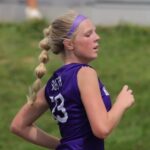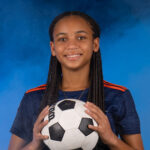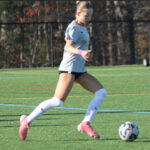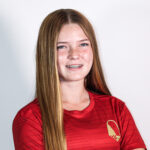Balancing the Books: What every coach can do to battle ACL injuries
 Last week we met two high school soccer players through the battles they and their families have waged against ACL injuries. Personal stories get our attention in a way that incidence rates and percentages, algorithms and return to play protocols never will.
Last week we met two high school soccer players through the battles they and their families have waged against ACL injuries. Personal stories get our attention in a way that incidence rates and percentages, algorithms and return to play protocols never will.
These are real kids. Real families. Real crises. The kids themselves plead, “Don’t let this happen to anyone else!”
[ +READ: What does an ACL really cost? The financial and intangible costs to players and families ]
While it’s hard to hear, I think we need to. Because so often we hear only the after-story, the ‘I struggled and I overcame story.’ Neatly wrapped in the silver lining.
But let’s not let that happy feeling allow us to set aside the hard stuff. I just get a glimpse of this as I talk to these kids and their parents. They have become experts on the subject of ACLs, knowledge honed over the many hours sitting by while their kid mends and rehabs.
These parents rehash the injury, playing it over and over in their minds. One mom told me she remembers every detail … the field conditions, the weather, the timing, the circumstances, the play, the player, the score, the coach, the ref team (or lack thereof), the presence or absence of warm up or availability of warm up space, the number of games played with little rest and recovery between.
So many factors to consider when we ask the very human question, why?
Eventually, in our own recovery as parents – and this is indeed a trauma one must recover from – we ask the very healthy question, how? How can we keep another child from experiencing this trauma?
A great deal of research and study has been applied to this issue in the last 30 (yes, 30) years. Indeed, many conferences, conventions and professional meetings, have attempted to bring together great minds to address this issue which hits hardest in the 15-25 year old age group and with special virulence against our girls.
Studies are ongoing, articles are being published, whole books printed on this topic alone. At present the consensus according to Dr. Tim Hewett at Ohio State University, who has dedicated his entire career to this research is, “The mechanism of non-contact ACL injury is still not fully understood.” (in Understanding and Preventing Non Contact ACL Injuries)
The list of potential risk factors is long: anatomical (joint structure, knee angle, ligament composition and size), physiological (hormonal cycle, neuromuscular and biomechanical recruitment patterns), environmental (field conditions, weather, refereeing), and player-related (skill, fitness and history of prior injury). To this list I would add style of play.
If you are completely exhausted just reading that list, you can imagine how parents feel who are trying to research this on their own. But the danger in looking at this very large and complex picture is the tendency to throw up our hands and say, How can I ever make a difference? Why even try?

Why? Because of Jane and Eve. They are the faces of the 1 in 100 female high school players and 1 in 10 female college players each year who tear an ACL, 25% of whom never return to their previous level of play.
Start here: Have you (or has your coach) implemented an injury prevention program for your team? Consistently employing the long version on training days; shorter version on game days? Good for you.
Is it working? You could wait it out and see, but here’s what I look for: balance. I work on:
- Balance right to left
- Balance front to back
- Balance side to side
Step 1. Teach Balance
Hold an imaginary mirror up to each kid. Is each drill, every skill, performed with balance? Can they can go to right and left equally. Is their range of motion equal in height, shape, form, and feel. Whatever they do, have them work toward doing it exactly the same on the other side. They will have different styles and approaches based on their age, gender, anatomy, fitness and familiarity with the motion. It’s okay. Help them be balanced.
Step 2. Practice Balance
Practice this balance so it becomes part of their play. Do it forward. Do it backward. Righty and lefty. Do everything dynamically with a focus and a target so they can gather feedback and feel their equilibrium.
Step 3. Coach Balance
Notice how kids react to their place on the field. Do they always look right, pass right, turn to the right, shoot right. Don’t let them. Set up your practice space to reward and encourage trying it the other way, the other foot, toward their weak side. Get them accustomed to playing off of both feet, on either side.
This is not natural for any of us; we are sided creatures. We favor one side. But athletes, and especially young athletes, can develop this ambi-dexterity and it will serve them well. This is especially true in fending off ACLs which are a twisting injury. Our best weapon is to be hinged and prepared to move in any direction.
(Caution: Many high school coaches take the elite club players who come their way and make them the centerpiece of their team, even when these players are used to playing (and seeing the field) from the outside on their club teams. This may not end well. Players have their “signature” moves. Their “go to” is not something they think about, it’s just what they do. When they default to it in an unusual place on the pitch, they are caught off guard or must react in an unaccustomed way. Both of these can spell disaster for a knee. We’ve got to make pivoting and defending 360 a natural, safe and automatic movement for our players.)
Step 3A. Coach for the Comeback
If the unforeseen does happen, be prepared to give the kids a hand back up. Parents, for sure, will be doing all they can. But they will be exhausted from doing the heavy lifting. Janet, Eve’s mom who has nursed two kids through five ACLs deflects the label “hero.” She writes, “My heroes are Eve’s spectacular coaches, Rob Kurtz and Mike Hayes, trainers, Jen Holliday Mohr, and PT Rob Woodside at Seneca Physical Therapy who were so encouraging and never gave up on her. They would text and lift her up.”
In fact, “Rob, the club coach developed a whole return to play program for (Eve) and would not take any money. He worked with her about three times a week all summer on his lunch break. He started her off at one v zero. Made her play against cones and coaching sticks until he could build her confidence. Then added players he could trust and worked from 1 v1 all the way up to 7v7. He watched her reaction on and off the ball to hard tackles and assessed. It was quite a gift.”
And even more, “Her trainer came to watch and give advice. Her previous coach helped me line up girls to help. The high school coach met with her and accepted her on varsity even though she could not compete during tryouts. Team Eve was a great example of generosity. ”
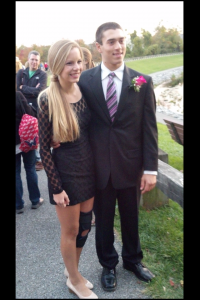
Janet concludes, “There are so many horror stories in youth soccer. I don’t know if Eve has a clue how lucky she is.”
Lucky. Now there is a silver lining. Eve was grateful she only had to sport the fashionable neoprene sleeve to the Homecoming dance. She was negotiating to wear heels, but her Mom drew the line at that. Add high heels to the list of female risk factors for injury.
Coaches and parents, we can do something about this injury by starting with what we have in our hands. Our players and our eye for how they move and how they play. Teach it. Practice it. Coach it. Care for it. We can’t erase the cost, but we can balance the books.
(author/editor note: If you like what you are reading from Fit2Finish, be on the lookout for Wendy’s new book: “Fit 2 Finish: Preparing soccer players to be healthy, play strong, and avoid injury”.)
SOCCERWIRE MARKETPLACE
- Start the Season Strong at Loudoun Premier Cup!
- 50th Annual Rael Vodicka Memorial Tournament
- Soccer Marketing Internships at The St. James FC
- Job Opening: The St. James FC Goalkeeper Academy Coach
- Full-Time Director of Goalkeeping for The St. James FC
- visitRaleigh.com Showcase Series 2025, hosted by NCFC Youth
- Join Official Elite Summer Soccer Camps with Europe’s Top Pro Clubs!
- OFFICIAL BAYERN MUNICH SUMMER CAMPS U.S.
- OFFICIAL FC BARCELONA CAMPS U.S.
- The Cup San Diego - Hosted by Legends FC



